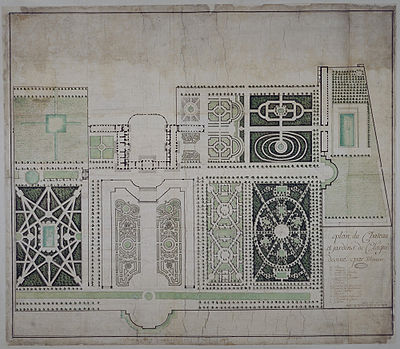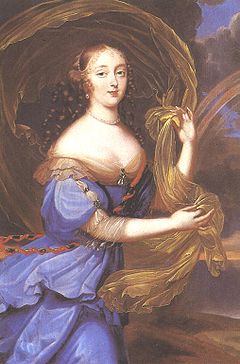
Château de Clagny
Encyclopedia

Palace of Versailles
The Palace of Versailles , or simply Versailles, is a royal château in Versailles in the Île-de-France region of France. In French it is the Château de Versailles....
; it was designed by Jules Hardouin-Mansart for Madame de Montespan
Françoise-Athénaïs, marquise de Montespan
Françoise Athénaïs de Rochechouart de Mortemart, marquise of Montespan , better known as Madame de Montespan, was the most celebrated maîtresse en titre of King Louis XIV of France, by whom she had seven children....
between 1674 and 1680. Although among the most important of the private residences designed by this great architect, it was demolished less than a century later after years of neglect.
Its appearance can only be traced through the engravings made of it, and scattered references in the archives of the Bâtiments du Roi
Bâtiments du Roi
The Bâtiments du Roi was a division of Department of the household of the Kings of France in France under the Ancien Régime. It was responsible for building works at the King's residences in and around Paris.-History:...
.
The Château de Clagny
Louis XIV had bought the estate of Clagny from the Hôpital des Incurables of Paris in 1665. On 22 May 1674, Colbert’s sonJean-Baptiste Colbert, Marquis de Seignelay
Jean-Baptiste Antoine Colbert, Marquis de Seignelay was a French politician. He was the eldest son of Jean-Baptiste Colbert, nephew of Charles Colbert de Croissy and cousin of Jean-Baptiste Colbert de Torcy....
submitted to him a plan designed by the young Mansart, who had used his family ties with the great François Mansart of the previous reign to make himself and his talents known at court. By 12 June, work was ordered to be begun at once because Madame de Montespan was anxious to start planting the grounds that very fall. André Le Nôtre
André Le Nôtre
André Le Nôtre was a French landscape architect and the principal gardener of King Louis XIV of France...
designed the layout of the gardens. In August 1675, Madame de Sévigné visited Clagny, which she described to her daughter:
- “We have been at Clagny, and what shall I tell you about it? It is a palace of Armida; the building rises à vue d’œil, the gardens are already made. You know what Le Nôtre is. He has left standing a little dark wood which is very nice; and next comes a little wood of oranges in great tubs: you can stroll in this wood, which has shady avenues, and there are hedges on both sides cut breast-high, so as to conceal the tubs, and these are full of tuberoses, roses, jasmine, and pinks. This novelty is certainly the prettiest, most surprising and ravishing that one could imagine, and the little wood is greatly liked.”
The orangerie
Orangery
An orangery was a building in the grounds of fashionable residences from the 17th to the 19th centuries and given a classicising architectural form. The orangery was similar to a greenhouse or conservatory...
where the "little wood of oranges" wintered at Clagny was a showpiece itself, paved with marble. In the gardens cabinets de verdure shaped into niches that held sculptures were clipped into the dense woods, fitted with trelliswork dadoes to fill in their sparse bases.
In a portrait painted by Henri Gascar
Henri Gascar
Henri Gascar was a French-born portrait painter who achieved artistic success in England during the reign of Charles II. He painted many leading ladies at court, including several of the King's mistresses, before returning to Paris...
, Madame de Montespan had herself painted while reclining on a baroque canopied couch, its curtains held up by carved cupids, with the barrel-vaulted galerie of Clagny visible behind her, as grand a piece of architecture as any sovereign could yet lay claim. About 1680, Adam-Frans van der Meulen painted a landscape view of a promenade en calèche with Louis XIV, Queen Marie-Thérèse
Maria Theresa of Spain
Maria Theresa of Austria was the daughter of Philip IV, King of Spain and Elizabeth of France. Maria Theresa was Queen of France as wife of King Louis XIV and mother of the Grand Dauphin, an ancestor of the last four Bourbon kings of France.-Early life:Born as Infanta María Teresa of Spain at the...
, Madame de Montespan, and the king's son and his wife, which includes in a single coup d'œil both Versailles and Clagny, showing how closely the two châteaux were located.

Poison affair
The Affair of the Poisons was a major murder scandal in France which took place in 1677–1682, during the reign of King Louis XIV. During it, a number of prominent members of the aristocracy were implicated and sentenced on charges of poisoning and witchcraft...
, she was abandoned by the king for Mme de Maintenon, the governess of the marquise's children. As a result of her loss of status at court, she visited the house less and less. In 1685, the king formally made it over to her as a gift, partially for the sake of their eldest natural son, the beloved Duc du Maine. In June 1692, Madame de Montespan retired to a convent.
After Madame de Montespan
At her death in 1707, the duc du Maine inherited Clagny, followed in time by his grandson, the Prince de Dombes, who as it turned out became the last of his line. The château reverted to the Crown in 1766.By then, the château, which Madame de Sévigné estimated to have cost not less than two million livres, and to have kept 1200 workers occupied, suffered from years of neglect. It was virtually unoccupied for forty years, and the dampness of the surrounding environment greatly accelerated its deterioration.
Gradually, the quartier nouveau of the town of Versailles
Versailles
Versailles , a city renowned for its château, the Palace of Versailles, was the de facto capital of the kingdom of France for over a century, from 1682 to 1789. It is now a wealthy suburb of Paris and remains an important administrative and judicial centre...
expanded to the edge of the estate of Clagny, nestling in the northern corner between the château and the étang de Clagny, the pond in its park. In 1736, following an episode of "fièvre paludéenne", possibly malaria
Malaria
Malaria is a mosquito-borne infectious disease of humans and other animals caused by eukaryotic protists of the genus Plasmodium. The disease results from the multiplication of Plasmodium parasites within red blood cells, causing symptoms that typically include fever and headache, in severe cases...
, in the quartier Notre-Dame of Versailles, it was decided to drain the pond and fill it in.
When the ownership of Clagny reverted to the Crown, Louis XV
Louis XV of France
Louis XV was a Bourbon monarch who ruled as King of France and of Navarre from 1 September 1715 until his death. He succeeded his great-grandfather at the age of five, his first cousin Philippe II, Duke of Orléans, served as Regent of the kingdom until Louis's majority in 1723...
gave some eleven hectares at the edge of the estate to his very religious queen, Maria Leszczyńska
Maria Leszczynska
Marie Leszczyńska was a queen consort of France. She was a daughter of King Stanisław Leszczyński of Poland and Catherine Opalińska. She married King Louis XV of France and was the grandmother of Louis XVI, Louis XVIII, and Charles X. In France, she was referred to as Marie Leczinska...
, who used the land to establish an Ursuline
Ursuline
The word Ursuline is used to describe the following:* The Ursulines, a Catholic religious order.Several schools named after the Ursuline religious order, including several named Ursuline Academy.Ursuline Academy or similar may refer to:...
convent which was built from 1767 to 1772 according to the designs of Richard Mique
Richard Mique
Richard Mique was a neoclassical French architect born in Lorraine. He is most remembered for his picturesque hamlet, the Hameau de la reine — not particularly characteristic of his working style — for Marie Antoinette in the Petit Trianon gardens within the estate of Palace of...
. The château was demolished in 1769. Some of its dressed stone was employed in constructing the nearby new convent and other stone found its way into the hôtels particuliers
Hôtel particulier
In French contexts an hôtel particulier is an urban "private house" of a grand sort. Whereas an ordinary maison was built as part of a row, sharing party walls with the houses on either side and directly fronting on a street, an hôtel particulier was often free-standing, and by the 18th century it...
along the new Boulevard de la Reine, built though the park in 1772. The park was further subdivided under the Second Empire
Second French Empire
The Second French Empire or French Empire was the Imperial Bonapartist regime of Napoleon III from 1852 to 1870, between the Second Republic and the Third Republic, in France.-Rule of Napoleon III:...
; one part now hosts the Science division of the Versailles Saint-Quentin-en-Yvelines University
Versailles Saint-Quentin-en-Yvelines University
Versailles Saint-Quentin-en-Yvelines University is a French university, in the Academy of Versailles.- Sciences :Located in Versailles and Le Chesnay....
and the pavillon Panhard
René Panhard
Louis François René Panhard was a French engineer, merchant and a pioneer of the automobile industry in France....
.

